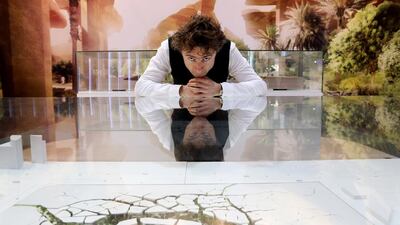On Wednesday night, at Manarat Al Saadiyat, an Olympian will discuss his plans for a particular patch of the capital.
Thomas Heatherwick’s name may not resonate with the public in quite the same way as “starchitects” such as Frank Gehry and Zaha Hadid.
But thanks to his design for the London 2012 Olympic cauldron, it is certain that at least 900 million people have a passing familiarity with the diffident Londoner’s work.
Mr Heatherwick is the man behind the reinvention of London’s famous double-decker bus, and the UK’s show-stealing Seed Cathedral pavilion at the Shanghai 2010 World Expo.
Now, thanks to a commission from the Salama bint Hamdan Al Nahyan Foundation, he will also design Al Fayah, one of Abu Dhabi’s newest parks.
“We’re really excited to finally have the first chance to talk about the project a little more,” says Mr Heatherwick, 44. “It’s a very unusual commission.
“It’s not a conventional building and it’s not a conventional park. It’s part architecture, part landscape, part cultural destination. It even includes a library.”
The plans for the new 125,000 square metre Al Fayah – which means “shade” in Arabic – Park were unveiled yesterday at Cityscape Abu Dhabi, but Mr Heatherwick and his 120-strong design team at Heatherwick Studio have been busy developing the project for two and a half years.
The park, which Mr Heatherwick describes as an “articulated landform”, will replace the formal lawns, picnic areas and playgrounds on Sheikh Rashid bin Saeed Al Maktoum Street, opposite the all-weather sports pitch at Rawdhat Abu Dhabi and the curving glass facade of the Hilton Capital Grand.
The design, which takes its inspiration from the topography of the emirates, features a cracked, sabkha, or salt flat, style landscape that will eventually rise 20 metres above ground level.
“We wondered what would happen if we pulled the desert apart and lifted it into the air so that you could be raised up and, at night, walk on top to view the Grand Mosque,” Mr Heatherwick says.
As the ground plane becomes the ceiling, each of the sabkha-like plates will also act as a shade for the open spaces below.
From inside, the park has been designed to look like a vaulted ceiling that, in Heatherwick Studio’s renderings at least, is reminiscent of an organic-looking undercroft, or even the columned halls of Cordoba’s great mosque-cathedral, the Mezquita.
“You’ll either be able to walk up on to the top of the park or down into its centre, where there will be lush planting and pools, like a wadi,” Mr Heatherwick says.
“The idea is to create a contrast between the desiccated desert, which is spectacularly dry and cracked, and the spectacularly lush planting that is revealed within those cracks.”
Building work is due to start early next year and the park is due to open two years later.
While Mr Heatherwick, who has also been involved in proposals for a park in Khalidiya and a mosque in Masdar City, accepts the design of Al Fayah Park is ambitious, he is keen to draw distinctions between this project and other headline-grabbing developments in the region.
“Ambitious things tend to be massive, stick up in the air and be huge, but we were interested in being ambitious in a different kind of way,” he says.
“There are buildings that are being built in Abu Dhabi that could exist anywhere in the world, but what we want is to create a landscape that wouldn’t be appropriate anywhere else.
“That’s what excited us – the opportunity to create a new kind of authenticity that’s inspired by the local context.”
That appreciation of context not only involves an understanding of the areas around the existing park – Airport Road, the new Al Noor Hospital and Zayed Sports City – but of the wider context as well.
“Is there a way to respect the desert while giving you the feelings that are associated with being in a park? Is there a way to celebrate the desert for what it is?
“The harshness of the climate here means that, to some extent, it’s an alien thing to make a park here that’s full of green plants.
“To us, the idea of taking a European-style park, unrolling that on to the desert like a piece of turf and then watering the hell out of it felt somewhat at odds with the local context.”
The park will also include a mosque, play areas, an outdoor cinema, a library, exercise paths and gardens where fruits and vegetables will be grown to supply the park’s food and drink outlets.
But the important thing for Mr Heatherwick is that the space represents an alternative to the semi-public gathering spaces in Abu Dhabi.
“People can be separated from each other quite easily in Abu Dhabi and often the only places that brings people together are shopping malls,” he says.
“The park is an opportunity to reconsider a leisure space that isn’t trying to sell you something and that isn’t overtly trying to teach you something.
“We’re interested in creating a space that will simply let you be.”
For Mr Heatherwick, Al Fayah park also represents an important opportunity to rethink the perception of the region’s landscape and some of the issues that tend to inform its design.
“We were aware that there was an existing, very exposed piece of ground that was using a lot of water and it felt to us like it was following a European model of what a park can be,” he says.
“We wanted to go back and reinvent a public space of nature, contemplation and leisure in the context of the utterly different climatic conditions of the Middle East.”
nleech@thenational.ae
Thomas Heatherwick will be talking on Wednesday night at Muntada: people, place and cities Manarat Al Saadiyat, 7.30-8.30pm
For more information and registration see muntada@shf.ae

